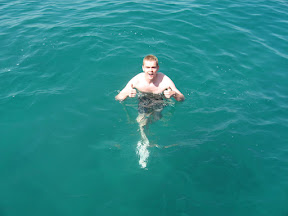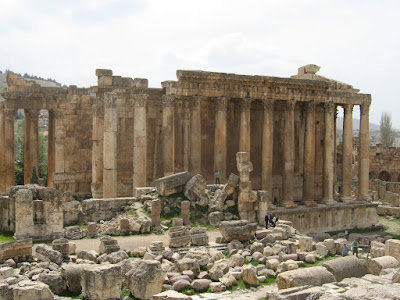Tuesday, March 23
Ben and I woke up in the early morning and caught a cab to Cairo International Airport. A couple of hours later, we were on board an 11:50 Middle Eastern Airlines flight bound for Beirut. After touching down in B-town and going through (the perplexingly challenging) customs, we caught a cab (that was way overpriced) and headed into town. After checking into our hotel we explored the beautiful campus of the American University in Beirut, and then wandered into town as the sun set and got a little lost.
Wednesday, March 24
Our classmates back at AUC were still in school, but Ben and I were on to our first attraction. We took some public transportation to Dawra, a circle in Beirut where buses congregate, and were soon on our way north to the Mediterranean town of Byblos. There, we explored a beautiful crusader castle, strolled through the quaint cobblestone streets, and I even took a dip into the beautifully blue sea. A short time after noon, we were on to our second destination of the day: the Jeita Grotto. We caught a bus back toward Beirut and it drop us off at the junction where the road to Jeita began. We caught a cab up the hill and through a valley and were soon at the grotto. The caves inside were truly captivating and its a shame we couldn't take pictures. We finished our time at Jeita with a subterranean boat ride in the lower cave aboard a vessel powered by an electric motor. After that, we said screw the taxi, and walked an hour and half back to the main highway, passing by some of the most gorgeous valley scenery I've seen in my life.


Thursday, March 25
We woke up very early and took a taxi to the Cola transport hub in south-side Beirut. From here, we took a minibus east, passing over some of the most treacherous mountain highway I've ever encountered. Our destination was the ancient Roman ruins of Baalbek, located two hours from Beirut, squarely located in Hizbollah territory. Upon arrival in Baalbek, we entered the site and spent the next four hours or so making our way through what certainly must be some of the most impressive Roman ruins in the world. When our sightseeing was over, we grabbed lunch, headed back to Beirut, and prepared for the evening. After a couple of overpriced drinks at a bar called The Blue Note (which charged us a hidden fee of $15 for the live music!) we tried our luck at getting into one Beirut's trendy night clubs, BO18. No luck. Those bouncers were some cold-hearted SOBs.
Friday, March 26
On our last day in Beirut, we explored the National Museum and discovered a treasure trove of artifacts and displays. Following our time at the National Museum, we set out in attempt to locate two more, the Robert Mouwad Museum and the Cirsock Museum. After searching for over two hours, we discovered that the Robert Mouwad Museum apparently no longer exists, while the Cirsock Museum was closed due to construction. We used the rest of the day to re-explore downtown Beirut, including its posh shopping areas, fancy eateries, as well as the imposing Al-Asin Mosque and its neighbor, St. George's Maronite Cathedral. After this, we rested up in preparation for the unpredictability that the next day held.


Saturday, March 27
Ben and I were at the Charles Helou Bus Station in time to catch a 7:30 am departure bound for Aleppo, Syria. When we reached the border some three hours later, the bus went on without us as we were left to deal with the Middle Eastern tourist rite-of-passage that is acquiring a Syrian visa at the border, something technically not allowed. However, the process was fairly painless, and only took three and half hours, certainly less than the five we had been anticipating. Once on the Syrian side, we caught a minibus to Homs and then a bigger bus to Aleppo. It was dark and rainy when we arrived, but nonetheless, after checking in at our hotel, we started exploring, a move that proved fruitless until we realized we'd been interpreting our map wrong for the past hour.
Sunday, March 28
Sunday was an all-day Aleppo day. We began with a visit to the plateau-topping Islamic citadel, an impenetrable structure with a single bridge for an entrance that evoked images from Lord of the Rings. After this, we explored the medieval bazaars of Aleppo, the Great Mosque, and then followed it up with a healthy does of churches in the Christian Quarter, most of which were unfortunately closed.
Monday, March 29
Our final destination for the day was Syria's capital of Damascus, but before that, we had an important detour: the legendary crusader castle known as Krak des Chevalliers. We took an early morning train from Aleppo to Homs and then caught a bus to Krak. We spent the next three or so hours exploring the massive structure. It was a bit cold out, but the gloomy skies added to the mystic of the place, and gave us a sense of foreboding that must would-be-siegers had to have felt when approaching the castle. Following Krak, we went back to Homs and then to Damascus. Night began to set in as we briefly explored this unfamiliar city, but we had an extremely memorable night. A visit to St. Anthony's Catholic Church yielded a meet and greet with Father Mark, a Spaniard who actually used to preside at the church I attend every Sunday in Cairo. Another exciting religious experience soon followed, as we were invited into a mosque to celebrate the Birth of the Prophet. We were provided with candy and nuts, given a front row seat, and listened to the entrancing song and fiery speeches for nearly two hours. After this, we returned to our hotel where I found out what sleeping on a roof means in hostel-speak.
Tuesday, March 30
We woke up early this morning- apparently too early for many of the attractions in Damascus's legendary walled Old City. We walked around for awhile before begining our sight-filled day, which included stops at the House of St. Anias (who baptized St. Paul) and St. Paul's Chapel (where St. Paul was lowered out of a window in a basket in order to escape the Jews). Following this, we entered the massive complex of the Ummayid Mosque, which was not only the biggest mosque I've been in yet, but also one of the most ornately designed. The mosque was also home of the final resting place of the legendary Islamic leader, Salah al-Din, a personal favorite of mine. After we'd exhausted all the Old City had to offer us, we took a minibus 40 minutes north to the sleepy little town of Malula. The main attractions here were Saint Takla's Convent and the Convent of St. Sergius and St. Bacchus (which boasts the oldest altar in the world), not to mention one of the few communities on earth that still speak Aramaic, the language that Jesus spoke.
Wednesday, March 31
Our goal for the day was to get to Amman, Jordan, but on the way we stopped at Bosra, Syria, which has the world's only freestanding amphitheater, a truly impressive structure. After Bosra we made our way to the Jordanian border, where the entrance process was relatively smooth. We had planned to see the Roman ruins at Jerash on our way to Amman, but we were in for a rude surprise: Jordan was an hour ahead of Syria, meaning we wouldn't be able to make it before the site closed. A little disappointed, we made it to Amman, checked in, and wandered around for a bit before turning in for the night.
Thursday, April 1
We were up at the crack of dawn, and caught a taxi to the JETT Bus Station, where we bought a ticket to Wadi Musa, the modern day town located right outside the ancient stone city of Petra, which is one of the "New Seven Wonders of the World." We entered Petra at about ten o'clock and proceeded to hike and climb in grueling fashion across nearly every square foot it had to offer, finishing our day off at the legendary Monastery nearly eight hours later. We returned to Wadi Musa, ate some dinner, found a place to sleep, and then collapsed into bed, nursing our tired feet and our severely sun burned shoulders.
Friday, April 2
On the agenda for the day was a visit to the crusader castle at Karak, followed by a trip north of Amman to Jerash, which we had missed a couple days earlier. There wasn't actually a bus straight to Karak from Wadi Musa, so we had to settle for one that dropped us off at a junction 36 kilometers east of our destination. We waited around for a few minutes before flagging down a bus, and in a few minutes we were at the foot of the cliff where the legendary castle of the dastardly Reynaud des Chatiollens (spelling!) stood. Apparently this guy used to take prisoners and throw them off the walls of the castle 400 meters to their death, even going to the trouble of putting a wooden box around their head so they wouldn't pass out before they hit the ground. After seeing the views from the castle, we could understand why one would pass out if the bottom of the valley was rushing to meet them. After Karak, we attempted to find a bus to Amman, where we would find transport to Jerash. Unfortunately, because it was Friday, transportation options were all but nil. We located a bus after awhile, but it took over two hours to get moving from the time we got on! Needless to say, we didn't make it to Jerash, and were lucky to make it to Amman before five. We spent the rest of the evening walking about and lounging in the hotel, still coping with the sunburn and exhaustion that Petra had doled out a day earlier.
Well, that's about it. It's 5:33 am, local time here in Amman, Jordan on Saturday, April 3. We're just over an hour away from boarding a bus that will take us to the Israeli border, where we will hopefully be granted entry. I'm looking forward to celebrating Easter in Jerusalem and exploring the Holy City for a couple of days before making my way back to Cairo on Tuesday.
Talk to you then, if not earlier.
Oh, and have a Happy Easter!


